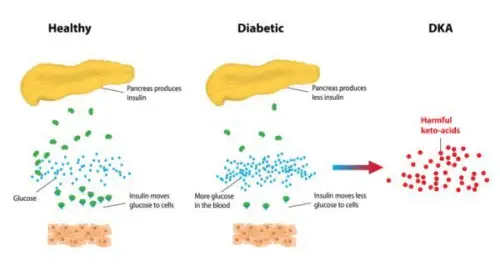At first glance, the terms “ketosis” and “ketoacidosis” seem interchangeable, but they are completely different in several ways. Read more to learn about these two phonetically identical, but medically different conditions.
Summary Table
| Ketosis | Ketoacidosis |
| Mainly caused by carbohydrate restriction | Mainly caused by extremely low insulin levels |
| Common among people with low carbohydrate intake | Common among patients with type 1 diabetes |
| Not life-threatening | Life-threatening |
| Symptoms include weight loss, appetite suppression, an increase in energy and focus, insomnia, digestive problems (i.e diarrhea), short-term fatigue, and bad breath | Symptoms include exhaustion, frequent urination, thirst, elevated glucose and ketone levels, dry skin, stomach aches, confusion, nausea, vomiting, breathing problems, and loss of consciousness |
| No treatment needed | Treatment plan includes proper fluid and electrolyte replacement and insulin therapy |
Definition

Ketosis is a normal metabolic state where the body burns stored fat instead of glucose to produce energy, which consequently leads to an increase in ketone levels in the body.

Ketoacidosis, on the other hand, is a life-threatening medical condition that occurs when the body produces extremely high ketone levels.
Ketosis vs Ketoacidosis
Both are conditions that are associated with the body’s ketone levels, but there is still a huge difference between ketosis and ketoacidosis.
Causes
Ketosis is caused by one major factor: carbohydrate restriction. Under normal circumstances, the body burns glucose to supply the body with the energy it requires. When a person follows a low carb diet, however, the blood glucose level drops, leaving the body with no choice but to burn protein and stored fats instead. Doing so, the body releases acidic by-products called ketones, leading to a condition called ketosis.
Ketoacidosis, by comparison, is triggered by extremely low insulin levels. This condition is most common among type 1 diabetic patients, whose pancreatic cells are severely damaged and are incapable of releasing insulin. Without insulin, glucose cannot be converted into energy, which eventually sends signals to the body, making it believe that it is starving. This consequently forces the body to burn protein and stored fats at a rapid phase until an extremely high level of ketones flood the blood.
Risk Factors
Ketosis is common amongst people who significantly cut down on their carbohydrate intake due to diet restrictions. For instance, those following a keto diet are prone to ketosis since they need to minimize their carbohydrate consumption to around 5% to 10%. Despite elevated ketone levels in the body, healthy individuals who follow this diet are least likely to suffer from ketoacidosis.
Instead, patients with diabetes type 1 may undergo ketoacidosis without regular insulin injections.
Also, malnourished patients who consume extremely high amounts of alcohol – which decreases insulin secretion – are also prone to alcoholic ketoacidosis.
Health and Safety
Although ketosis involves the release of ketones in the body, it is not considered a life-threatening condition. In fact, the keto diet, which is a low carb diet that leads the body to a state of ketosis, was originally devised to treat epileptic patients.
Ketoacidosis, by contrast, is a condition where the body produces ketones to the point of toxicity. As the body overproduces ketones at an alarming rate, the blood becomes highly acidic, making it deadly if left unmanaged.
Symptoms
When under the state of ketosis, individuals can experience both positive and negative changes, depending on the level of ketones in their body. For one, the keto diet has risen in popularity because it leads to weight loss, appetite suppression, and an increase in energy and focus.
On a negative note, starting the keto diet can cause insomnia, digestive problems (i.e diarrhea), and short-term fatigue since the body still needs to adapt to diet restrictions. Also, reaching a full state of ketosis can cause bad breath, which is due to the release of acetone (a type of ketone) in the breath.
Ketoacidosis, on the other hand, is a far more aggravating condition that needs immediate attention. During its early stages, ketoacidosis usually causes exhaustion, frequent urination, thirst, an elevated glucose and ketone level, and dry skin. Some of the hallmark signs of progressive ketoacidosis include stomach aches, confusion, nausea, vomiting, breathing problems, and loss of consciousness.
Treatment
Ketosis is not an alarming condition that needs treatment unless it progresses to ketoacidosis, which is considered a medical emergency. The good news is, while ketoacidosis may be life-threatening, it is highly manageable. With proper fluid and electrolyte replacement, along with insulin therapy, the ketone levels in the blood can significantly drop. Nonetheless, patients suffering from ketoacidosis are usually advised to stay in the hospital for a few hours for monitoring.





